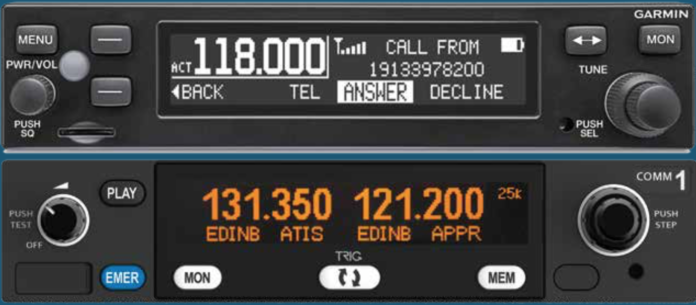The Icom and Sporty’s portable radios are worthy for use as primary radios, but add up the labor and parts needed to install an external antenna system t, Garmin’s GTR 200B PMA.
The non-certified GTR 200B trickles down from Garmin’s higher-priced GTR 225 radio, which has a TSO, but the $1839 PMA’d version of the radio is fair game for installation in certified aircraft, a point Garmin doesn’t openly advertise mainly because the radio is intended for use in the STC’d G3X Touch integrated retrofit avionics suite. Still, we’ve heard from a handful of installers who put them in as standalone radios. There are a lot of good features as standard.
The GTR transmits 10 watts of power and measures 1.35 inches tall by 6.25 inches wide. The radio makes use of a simple 37-pin connector, which stretches the chassis 9.3 inches deep. The entire system weighs just shy of two pounds, including mounting rack and connector hardware. The radio’s display has a versatile 45-degree side viewing angle and measures 3.0 x 0.48 inches, with a 200 x 33 pixel resolution—a decent read in sunlight and in the dark.
The GTR 200 has some modern tricks, including a bezel key that’s dedicated to monitoring the standby frequency. Garmin took the interface one step further and built in its 3D audio function, which trickles down from its flagship audio panels. This provides special separation of the standby and active frequency in each ear when wearing a stereo headset. The 3D function spills over to the intercom function, too, separating the passenger chatter from one ear to the other. You can also send in an auxiliary input (maybe music input or a landing gear or low fuel warning), and that audio is controlled with a dedicated bezel key. If you want to pipe the entertainment audio in via Bluetooth, spend the extra $196 for the Bluetooth model—a no-brainer, in our estimation. The radio puts an emphasis on entertainment input and has bass boost as we’ll as a pop, classical and rock genres music equalizer.
Kicking the interface up a notch is a smart feature that displays the facility name and type when you are tuning from one of the 20 user-defined frequency preselects, or selecting a frequency from one of the nearest or flight plan airports. These are transferred from later Garmin aviation portable navigators.
The other standout is the $1865 Trig Avionics TY96A. The 10-watt radio stands 1.3 inches tall in a standard 6.2-inch-wide radio stack, requiring 10.63 inches of panel depth, and weighs 2.09 pounds.
The “A” suffix Trig radios have basic 25 kHz channeling (the straight TY97 and 96 have both 25 kHz and 8.33 kHz channeling). All models come standard with a two-place stereo intercom and aux input for entertainment and warning systems. Trig radios can integrate with compatible GPS navigators using the Garmin SL-40 and GTR 225 data protocol to automatically display frequencies along a route, based on GPS position. This is a serial data connection between the radio and the navigator.
The Trig radios also have a dedicated Mon bezel key for monitoring the audio of the standby frequency (something Trig calls Dual Watch), an Emer key for quick tuning the 121.500 emergency frequency and a Play button for playing back 30 seconds of the previous receiver audio. The radio comes with a USB memory stick for building a customizable frequency database for loading (up to 200 channels and their associated facility names) into the radio as CSV files. The USB port is on the lower left front of the radio’s bezel, and there’s a Mem key for accessing the frequencies.
Before investing in a permanent install for a portable, get a quote for the Garmin and Trig—for some aircraft the investment makes better sense.





